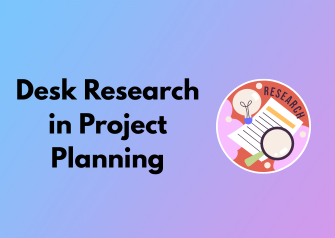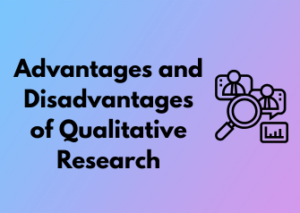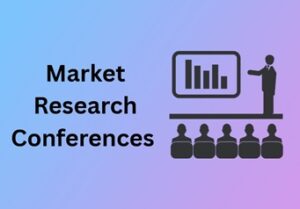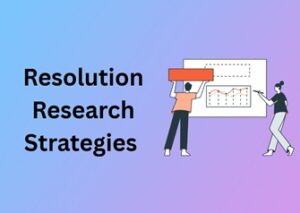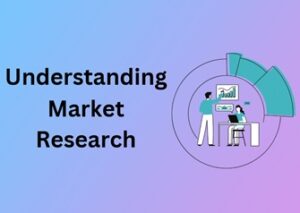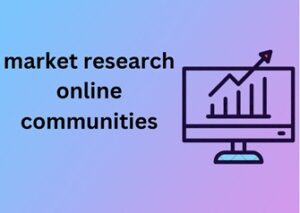Hello there! Let’s chat about desk research and why it’s such a crucial step when you’re starting a new project. Now, I know research doesn’t always sound thrilling, but hear me out—desk research could save you loads of time, energy, and resources while setting you up for success. Ready to dive in? Let’s go!
First things first: what exactly is desk research? Also known as secondary research, it’s all about gathering information that’s already out there—books, reports, articles, online databases, and more.
This isn’t the part where you head out into the field or conduct interviews; instead, you’re leveraging existing knowledge to build a solid foundation for your project. Think of it as doing your homework before jumping into anything major.
Why Projects Soar With Desk Research
Imagine starting a project without knowing much about the industry trends, target audience, or challenges you could face. Sounds chaotic, right? Desk research ensures you’re not walking in blind. Here’s why it’s so valuable:
- Fills Knowledge Gaps Efficiently: Not everyone is an expert on everything. If you’re entering a new field, desk research gives you the quick education you need to get up to speed.
- Helps Define Your Project’s Scope: It’s easy to overestimate what you can achieve in a project. By understanding the current landscape, you can set realistic and achievable goals.
- Prepares You for Challenges: Spotting potential obstacles early in the game means you can plan effectively and avoid costly surprises later on.
- Builds Credibility: When your recommendations or next steps are rooted in solid research, you stand out as someone who’s well-prepared and informed.

When Desk Research Shines Brightest
It’s worth mentioning that desk research isn’t just a box to tick—it’s a tool to give you confidence in your decisions. Let’s say you’re launching a new product. By researching competitors, market trends, and customer preferences, you’ll be able to refine your offering. Or perhaps you’re preparing a grant proposal? Desk research will ensure your funding pitch is backed with evidence, giving you an edge.
Pro Tip: Keep Your Purpose Clear
One key to effective desk research is knowing what you’re looking for. Are you studying the competition? Exploring consumer behavior? Investigating best practices? Start with a clear set of questions to guide your search. Trust me—it’ll keep you from spiraling down random internet rabbit holes!
Best Sources for Desk Research
Not all sources are created equal, and it’s important to stick to credible ones. Here are a few great places to start:
- Government Websites: Think census data or economic reports—they’re packed with reliable info.
- Industry Studies and White Papers: These are goldmines if you want insights straight from the experts.
- Academic Journals: Perfect for digging into in-depth research and validated findings.
- Business and Market Reports: Loads of companies publish valuable reports on trends and benchmarks.
How Desk Research Differs from Other Research Methods
Ah, desk research – that quiet superhero of the research world. While it may not involve lab coats, field trips, or long interviews, desk research is a methodological powerhouse when used correctly. But how does it differ from other research methods, and what makes it so special? Let’s dive into it!
1. Desk Research Stays Behind the Scenes
Picture this: You sitting at your desk (or maybe your favorite couch) with your laptop, combing through credible reports, studies, and articles. That’s the essence of desk research. Unlike primary research, where you’re directly gathering new data through surveys, experiments, or interviews, desk research focuses on existing data. It essentially means using resources and knowledge that’s already available, rather than having to create it from scratch.
For example, instead of conducting a survey to understand customer preferences, desk research might involve reviewing past surveys, market analysis reports, or articles from industry experts. This makes it a much faster and often more budget-friendly method of research. Who doesn’t love a time and cost-efficient hero?
2. No Direct Interaction with People
Primary research typically involves stepping out (or hopping onto Zoom) and directly interacting with individuals – whether through questionnaires, interviews, or focus groups. On the other hand, desk research is your “quiet” alternative. You’re not talking to people directly; rather, you’re letting their previously shared insights and data guide you.
This arm’s-length approach is especially beneficial when working with sensitive topics, limited timelines, or resources that make outreach impractical. Unlike ethnographic research or interviews, desk research doesn’t require participants – it’s all you and the treasure trove of information online or in libraries.
3. Broader Scope of Information
Desk research allows you to dig deep across various sources and industries without the confines of a specific study group or experiment. Newspapers, academic journals, government databases, and even competitors’ websites – all of these are a click or search away. By comparing multiple sources, you’re not bound by the limitations of a single dataset, as you might be in primary research.
It’s like being handed the key to a massive library, instead of being asked to write your own books from scratch. You can explore global patterns, historical trends, and cross-sector knowledge, all from the comfort of your workspace.
4. It’s a Starting Point, Not the Whole Journey
It’s important to note that desk research isn’t necessarily about providing brand-new insights. Instead, it lays the groundwork. Think of it like baking: desk research gives you the ingredients and the recipe so you can hit the kitchen (i.e., the rest of your project) prepared. If a project calls for more robust, detailed findings, desk research can identify the gaps where primary research is needed.
5. Real-World Applications of Its Simplicity
- Quick Answers: Have a quick business question? Desk research can often answer it without needing to dive into time-consuming primary research.
- Broad Understanding: It’s an excellent way to gain context and stay informed on a high level before narrowing down your research focus.
- Cost Efficiency: While organizing surveys or experiments might cost a pretty penny, desk research makes the most of free or low-cost resources.
At its core, desk research is about working smarter, not harder. By leveraging data that already exists and crafting a foundation of knowledge, it sets the stage for thoughtful, informed decision-making. So the next time you find yourself overwhelmed thinking you need to reinvent the wheel, just remember: sometimes, the answers you need are just a diligent search away. Happy researching!
Essential Types of Information Gathered Through Desk Research
When embarking on a new project, desk research is an invaluable way to collect the background information needed to build a strong foundation. Whether you’re working on a business case, a research proposal, or a strategy document, knowing what types of information to prioritize can save time and significantly enhance your results.
Let’s explore the essential types of information that desk research often uncovers and why it’s so important.
1. Industry Trends and Market Insights
One of the most common types of information gathered during desk research is insight into the current trends shaping your industry. By consulting reports, white papers, and authoritative publications, you can understand the big-picture dynamics—think market shifts, emerging technologies, or changing regulations.
Pro Tip: Check reliable sources like government databases, industry journals, and reputable consulting firm publications (e.g., McKinsey or Deloitte). These not only provide verified statistics but also offer forward-looking analyses.
2. Competitor Analysis
If your project involves working in a competitive space, understanding what similar organizations or projects are doing is critical. Desk research enables you to dive deep into competitors’ strategies, products, services, marketing efforts, and even customer feedback.
Look at company websites, annual reports, and social media activity for fresh insights into how they’re positioning themselves. You’ll uncover details like pricing models, key differentiators, and areas where they may be underperforming—something your project can capitalize on!
Remember: Legal and ethical methods only! Stick to publicly available information.
3. Target Audience and Demographics
To meet your project’s goals, you need to know the people it will serve. Demographic data such as age, gender, location, income level, or buying preferences can make or break your project’s relevance. This type of information can be sourced from consumer behavior studies, statistical databases, or customer surveys conducted by other reputable organizations.
For example, the U.S. Census Bureau or Eurostat are treasure troves of demographic and socioeconomic data that are publicly available. By gathering this information, you’ll be able to craft solutions that resonate deeply with your audience.
4. Case Studies & Best Practices
Another gold mine of information lies in reviewing existing case studies or reports on best practices in your field of work. These not only highlight successful strategies but also showcase potential pitfalls to avoid. Oftentimes, industry organizations or academic research papers will publish detailed examples that you can benchmark against your project plans.
Learning through the experiences of others is often faster than starting from scratch—and it can save you from costly lessons down the road.
5. Historical Context & Existing Knowledge
Finally, don’t underestimate the value of understanding the historical developments leading up to your project. This includes reviewing past efforts in similar domains, assessing their outcomes, and identifying lessons learned. Historical data is particularly valuable for sectors like education, public health, and policy development, where the context matters as much as the ideas themselves.
This type of research might involve digging into old documentation, archival reports, or academic studies. While this can be a bit time-intensive, the insights gained can provide clarity on how past strategies fared and ways to improve them for the future.
Quick Checklist for Desk Research Information
- Look for up-to-date industry trend reports and stay current.
- Gather as much detail as possible on your target audience.
- Research competitor strategies to define your project’s unique value.
- Seek case studies or examples of what worked for others.
- Understand the historical background to avoid reinventing the wheel.
By focusing on these essential types of information during your desk research, you’ll be equipped to set your project up for success in both planning and execution phases. Knowledge is powerful—in fact, it might just become your project’s secret weapon!
Key Steps to Conducting Effective Desk Research
Desk research can be incredibly valuable for laying the groundwork of your project, but only if done right. Think of it as your opportunity to become a detective—hunting for insights through various sources without leaving the comfort of your chair (or desk). Let’s break down the essential steps to conducting desk research in an effective and efficient way.
1. Clearly Define Your Objective
Before you dive headfirst into the vast sea of data, take a moment to ask yourself: What exactly are you looking for? Having a clear objective will stop you from getting lost in irrelevant information. Define a purpose for your research that aligns with your project’s goals. For example, are you gathering market trends, analyzing competitors, or understanding customer preferences? A well-focused objective will steer your desk research in the right direction.
2. Identify Reliable Data Sources
Not all sources are created equal, and this is where quality beats quantity every time. Aim for credible and up-to-date sources that align with your topic. Here are some examples of dependable sources you can explore:
- Government websites: Great for accessing official statistics, policy documents, and census data.
- Academic journals: Perfect for finding peer-reviewed studies or literature analysis.
- Industry reports: Offered by trusted organizations, these provide current trends and market insights.
- Competitor websites: A creative way to analyze offerings, strategies, and audience engagement patterns.
- News outlets: Look for reputable publications to stay informed about recent developments.
Just remember, verifying the reliability of your sources is key. For example, a random blog post may not hold the same weight as a report published by a recognized research firm.
3. Plan and Organize Your Research Process
Desk research can feel overwhelming if you don’t approach it systematically. Create a roadmap for your research, breaking down your process into manageable steps. Start with broad searches, gradually narrowing your focus as you dig deeper into your topic. Tools like spreadsheets, mind maps, or note-taking apps can help you stay organized while recording key takeaways.
4. Use Targeted Keywords for Search Efficiency
A lot of desk research happens online, which means search engines will be your best friend. Crafting smart keywords can save you a ton of time. Combine specific phrases, like “2019 eco-friendly fashion sales USA” instead of just searching “fashion statistics.” Feel free to experiment with Boolean operators (e.g., AND, OR, NOT) and quotation marks to improve search accuracy.
5. Take Notes and Analyze the Data
As you collect information, take time to consolidate your findings into digestible chunks. Keep track of where each piece of data comes from so you can easily revisit sources if needed. Look for patterns, gaps, and recurring themes in the data. This step is about moving beyond simply collecting information—start critically thinking about how the data ties back to your original objective.
6. Set a Time Limit for Research
Desk research can easily turn into a rabbit hole if you’re not careful. Set a timeframe for each stage of your research to maintain productivity. Keep reminding yourself of the goal: capturing actionable insights, not perfection!
7. Cross-Reference Your Findings
To ensure accuracy and relevance, cross-check your findings with multiple sources. If two or more credible sources align, you can feel more confident in the reliability of the data. This will also help prevent unintentional bias or reliance on outdated information.
Common Mistakes to Avoid During Desk Research
Desk research is an invaluable tool, but like any method, it’s not immune to pitfalls. The good news? By simply being aware of these common mistakes, you can sidestep them and make your desk research process smoother and more effective. Let’s dive into some of these missteps and how to avoid them, with a friendly nudge toward better practices!
1. Relying Too Heavily on Outdated Sources
One of the most frequent mistakes in desk research is overlooking the importance of up-to-date information. A 10-year-old industry report may offer an interesting historical perspective, but it’s hardly the most reliable foundation for current decision-making.
Always check publication dates and aim for the most recent and relevant data available. If no recent materials exist, consider how the passage of time may have impacted the information — and make this clear in your notes!
2. Trusting Unverified Sources
Not all sources are created equal, and the internet is a mixed bag of reliable gems and questionable content. Avoid falling into the trap of leaning on unverified websites, blogs, or opinion pieces, especially those without proper citations or a credible author.
Trustworthy sources often come from government reports, academic journals, reputable organizations, and renowned experts. When in doubt, cross-check information with multiple credible references. If something feels off, it probably is!
3. Skimming Too Quickly Without Context
Admit it—sometimes we skim materials to “save time.” While scanning can quickly reveal key insights, it often leads to missing crucial context. A graph showing a rise in sales might look impressive, but does the accompanying text explain why (or whether) external factors were at play? Take the time to dig into the details and fully understand the data before drawing conclusions. Trust us, a little patience goes a long way here!
4. Overlooking Niche or Specialized Sources
Ever stick to only the first two pages of search results? You’re not alone. Many researchers miss out on specialized, industry-specific, or lesser-known resources that can provide deep insights. Instead of just searching broadly, try exploring targeted databases, trade publications, or niche websites tailored to your topic. Sure, they may require some extra digging, but the unique perspectives are worth the effort.
5. Not Taking Good Notes
Imagine finding the perfect statistic or quote, only to realize you forgot to note where it came from. Frustrating, right? Disorganized or incomplete notes are a common oversight that can derail your progress later (and cause a major headache if you need to revisit anything). Always keep detailed records of what you’ve researched, including links, publication dates, and author details. Organize everything neatly—your future self will thank you!
6. Ignoring Bias in Sources
Every source has some degree of bias, whether intentional or not. Government reports may reflect policy perspectives, corporate white papers might promote a product, and even academic research can carry funding-related agendas. Be mindful of these potential biases while evaluating your materials. Question key points and consider whose interests are being represented. The more critical you are, the stronger your conclusions will be.
A Handy Recap:
- Stay current—opt for recent, reliable data.
- Be skeptical—not all sources are trustworthy.
- Dig deeper—don’t skim away key context.
- Think outside the box—consider niche resources.
- Organize meticulously—track and record everything.
- Stay critical—identify and account for bias.
Now that you know what not to do, you’re one step closer to mastering the art of desk research. Avoiding these common errors will set you up for success, help you build a strong foundation of reliable data, and make your project planning efforts shine. Remember—it’s not about working harder, but smarter. Happy researching!
Validating Desk Research Data for Greater Accuracy
Let’s be honest—desk research can often feel like a treasure hunt. You’ve unearthed articles, studies, stats, and reports that seem like the answers to every question your project asks. But here’s the kicker: not every shiny “gem” you find online is actually valuable. That’s why validating your desk research data is an absolute must for ensuring high-quality, reliable insights.
Why Validation is Essential
Simply put, data validation makes your research more trustworthy. Imagine building a house; you wouldn’t want a shaky foundation, right? The same applies here. Without careful validation, you run the risk of making decisions based on incorrect, outdated, or biased information. And let’s face it—no one has time for that! Whether you’re preparing a business proposal, writing a report, or planning a new project, inaccurate data can derail your efforts faster than you can say “citation needed.”
Key Strategies for Validating Desk Research Data
Now, let’s tackle the “how.” Below are some approachable and effective strategies to help you validate the data you collect:
- Check the Source’s Credibility: Always keep an eye on where your data is coming from. Trusted sources such as academic institutions, peer-reviewed journals, government reports, and renowned organizations are usually safe bets. Be wary of blogs or personal opinions lacking proper citations—they might not hold up under scrutiny.
- Compare Across Multiple Sources: If you’ve found fascinating statistics or claims, back them up by cross-checking with different sources. Consistency is key—if three reliable references agree, you’re likely on solid ground.
- Look at Publication Dates: Is the data current? In rapidly changing industries like technology or medicine, even a few years can make a big difference. Ensure your findings are up-to-date and relevant.
- Beware of Bias: It’s human nature to lean into data that supports your point of view, but it’s a trap! Always evaluate the potential biases of the authors or organizations that produced the data. For example, a study sponsored by a company promoting its product may not offer the most objective insights.
- Understand the Collection Methods: Dig into the methodology if it’s available. Was the research conducted using a sound, scientific process? Survey size, sample diversity, and transparency in data collection play a huge part in determining reliability.
Error Signals to Watch For
Sometimes, red flags stand out right away. Avoid relying on sources with:
- No clear author or organization information.
- Overly broad or exaggerated claims that sound too good to be true.
- Lack of citations or references to support their data.
If any of these issues pop up, proceed with caution—or better yet, skip the source entirely.
The Result? Smarter Decisions
Taking the time to validate your desk research isn’t just about impressing others with how “thorough” you are (though that’s definitely a perk). It’s about arming yourself and your team with accurate, dependable data that ensures your project or report is on the right track. By following these tips, you’re setting yourself up for outcomes you can stand behind confidently. Trust me, it’s worth it!
So, give your data the once-over (or twice… or thrice), and enjoy the peace of mind that comes with knowing your insights are rock-solid. Happy researching!
Leveraging Desk Research Insights for Real-World Applications
So, you’ve gathered and validated your data, organized your findings, and now you’re wondering: what’s next? This is where the real magic of desk research comes to life! Leveraging desk research insights for practical, real-world applications is like turning raw ingredients into a gourmet meal. Let’s explore how these insights can be harnessed to deliver impactful results, whether for a business strategy, personal project, or something else entirely.
Connecting Data to Your Goals
First things first: always tie your research findings back to your original project goals. It’s easy to get lost in a sea of fascinating data, but remember, the goal of desk research isn’t to collect information for information’s sake — it’s to support informed decision-making.
Ask yourself: What problem am I trying to solve? or What decision is this research guiding? By focusing on how your data aligns with these objectives, you can start creating actionable strategies. For example:
- Launching a new product? Use competitor analysis and market trends discovered during your research to carve out a unique value proposition.
- Optimizing a marketing campaign? Blend demographic insights with online behavior patterns to refine your target messaging.
- Developing policy? Rely on precedent and existing case studies to predict potential outcomes or risks.
Transforming Insights into Action
Desk research is all about application. Once you’ve identified trends, gaps, and opportunities, the next step is to distill these findings into practical actions. Here’s how you can do it like a pro:
- Summarize Key Takeaways: Take the hundreds of individual data points and boil them down to a few clear, concise conclusions. The goal is to answer questions, not overwhelm with statistics.
- Create Actionable Recommendations: For every insight, there should be a practical next step. For instance, if market trends indicate that consumers prefer eco-friendly products, one actionable recommendation could be adopting sustainable practices in your product line.
- Communicate Clearly: Whether you’re sharing findings with a team, stakeholders, or clients, your insights should be presented in a way that’s easy to understand and inspires confidence in the data. Consider engaging visualizations like charts or infographics — sometimes, a picture really is worth a thousand words!
Scenario-Based Applications
Let’s put this technique into context with a real-world example. Say your organization wants to open a new café in your city. How might desk research support this decision?
– Understand the Local Market: Start by analyzing competitor locations, customer reviews, and rent costs for commercial spaces. These insights pinpoint areas with high demand but lower direct competition.
– Customer Preferences: Comb through existing research (perhaps surveys or government reports) to spot trends like popular coffee blends or customer interest in a workspace-friendly atmosphere.
With these two insights in hand, you now know where to locate your café and what features to emphasize to attract your target audience — all thanks to desk research!
Why Insights Are Only the Beginning
While leveraging desk research insights is undeniably powerful, it’s essential to remember that they’re not the endgame. Instead, they’re a launchpad. Think of them as a puzzle piece: valuable on its own, indispensable when combined with other forms of research, observed market trends, or conversations with experts.
The beauty of desk research is in its flexibility and ability to build momentum for your next step. Every dataset, no matter how small, has the potential to spark an idea, adapt a strategy, or move your project forward.
Final Thoughts
To really make the most of your desk research, don’t let your findings sit in a document gathering digital dust. Instead, integrate them into your decisions, strategies, and plans. And remember — the journey doesn’t stop here. Ongoing analysis and feedback loops are key to keeping your insights relevant in an ever-changing world.
So go ahead. Dive deep, share your discoveries, and watch those insights come to life in the real world!

